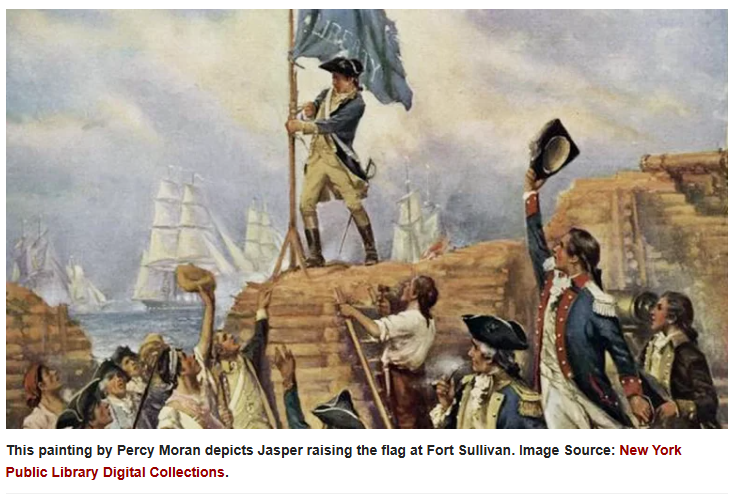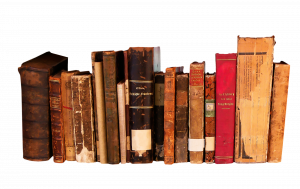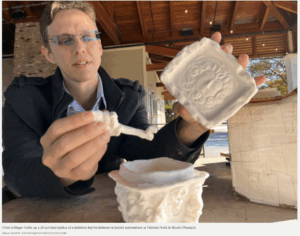South Carolina played an outsized role in the Revolutionary War, though it is one that has largely been overlooked by what happened elsewhere, as well as the oversized symbolism the Palmetto State carries from the Civil War.
Years of efforts to highlight that historical record by the S.C. Battleground Trust, the S.C. American Revolution 250th Commission and others will fully coalesce in 2026. Next year, the nation celebrates the 250th anniversary of its independence from Great Britain — one that was hard-fought over six years, with pivotal moments at the end of the war taking place here.
“The mission of SC250 is to educate, engage and inspire South Carolinians and visitors the significant role that South Carolina played in the American Revolution,” said Rich Thomas, chair of Beaufort250. “The county committees amplify that mission at the local level.”
Nationwide, events are planned throughout the year as part of America250, a long-planned initiative to mark the anniversary of the signing of the Declaration of Independence.
That’s not to overlook a key victory that took place near where the Ashley and Cooper rivers come together to form the Atlantic Ocean just weeks before July 4, 1776.
Today, we mark Carolina Day — the anniversary of the Battle of Sullivan’s Island, which has been commemorated for 249 years for good reason, said William Grimsley, chair of SC250.
“Charleston was the richest city in British North America at the start of the Revolution. It was always regarded as a lucrative prize for whoever controlled it,” Grimsley said.
Losing the Battle of Sullivan’s Island and failing to capture Charleston stung the British, causing some in England to question whether the war against the colonists could be won. It also changed minds on this side of the Atlantic.
“All of a sudden (the Patriots) have this massive victory at a time when there hadn’t been many victories,” Grimsley said, adding that the loss here forced the British out of the Carolinas for three years.
Over the rest of this year and throughout 2026, The Post and Courier will continue to explore the history of the Revolutionary War, both here in the Charleston region and across our great state.
‘Shot heard round the world’ fanned flames here
More than a year before the Declaration, the first shots of the American Revolution and the lore of Paul Revere was born in the outskirts of Boston. Convinced a rebellion was imminent, the British began an overnight march to Lexington, Mass., to seize guns and gunpowder. Revere, as carved into American history lessons, raced ahead of them with his famous warning.
When British troops arrived early April 19, 1775, they found a waiting-and-ready militia more than 70 strong. Someone fired a shot, then the fighting began. In the end, the British killed eight and then continued on to Concord, according the American Battlefield Trust.
A group of nearly 400 militia, or Minutemen, gathered to fight, first losing a couple of men before returning fire and killing three British soldiers and wounding others in a volley that became known as “the shot heard round the world.” They chased the British back to Lexington where the early militia got their revenge along Battle Road and all the way back to Boston.
By day’s end, the British counted 73 casualties compared to the Patriots’ 49.
Word traveled fast to the rest of the colonies.
The following passages, from an article by historian Michael Cecere published this month in the Journal of the American Revolution, details the reaction in South Carolina:
The news of Lexington and Concord reached Charleston on May 8 and was met with outrage. Henry Laurens lamented to his son in London that “The Sword of Civil War was drawn in the environs of Boston on the 19th of April.”
He wrote a more detailed letter a week later that declared,
“We will go forth & be ready to Sacrifice our Lives & fortunes in attempting to Secure (our) Freedom & Safety … The daily & nightly Sound of Drums & Fifes discover a Spirit in the people to make all possible resistance against that arbitrary power complained of … In a word, the people are resolved to do all in their power to resist against the force & Stratagems of the British Ministry.”
William Moultrie remembered that the people of South Carolina at this time were greatly alarmed and anxiously awaited the decisions of their Provincial Congress:
“They saw that a war was inevitable, and that it was to be with the country which first planted them in America, and raised them to maturity; a country with which they were connected … by custom, and by manners; by religion; by laws; and by language; a country that they had always been taught to respect.”
“With little money, arms, ammunition, generals, armies, or fleets,” continued Moultrie, South Carolina’s Provincial Congress “determined upon a defensive war.” Several ships were sent to the West Indies to procure gunpowder, and the Provincial Congress authorized two regiments of infantry (the only regiments of “regular” troops raised outside of New England at the time) comprised of 500 men each along with a smaller 300-man regiment of mounted rangers.
Henry Drayton, a leader in South Carolina’s Provincial Congress, believed it would not be long before South Carolina joined Massachusetts in war. Drayton noted on July 3:
“Peace, Peace, is now, not even an Idea. A civil War, in my opinion, is absolutely unavoidable. We already have an Army & a treasury … In short a new Government is in effect erected.”
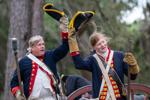
Members of Kingsbury Artillery prepare to fire a cannon on the site of the Old House Plantation in Ridgeland, May 3, 2025. The gravesite of Thomas Heyward Jr., a signer of the Declaration of Independence who is buried at Old House, was rededicated during a ceremony there.
South Carolina’s legacy
While the American Revolution is remembered for having started in New England and ended in Virginia, more skirmishes and battles — at least 100, with some counts eclipsing 300 — were fought in South Carolina, which is more than in any other state. The Palmetto State, in the end, played a pivotal and decisive role in the outcome.
More than 10,000 South Carolinians helped the American cause either by fighting in the militia or providing food, horses or other aid.
In large part, the Patriots’ ability to drag out the fight with the British and keep them from taking complete control of the state also prevented their troops from being able to move north and join forces to fight Gen. George Washington and his troops.
Nearly every region of South Carolina was involved in the nation’s fight for freedom. Like in other places, the war also resembled something of a civil war here, with colonists often torn between the Patriot cause and Loyalist leanings.
Despite the significance of South Carolina’s role in the American Revolution, its significance isn’t well understood outside the state, or even by South Carolinians. Grimsley offered his thoughts on why that’s the case.
“When history was written, it centered strongly and rightfully on George Washington. So wherever Washington was during the war is where most of the historic accounts tend to focus. In many cases, the Southern Campaigns aren’t necessarily forgotten, but they are maybe sidelined,” he said.
There’s little doubt that the 1776 victory at Sullivan’s Island influenced the signing of the Declaration of Independence. There are, however, different opinions as to whether or not the Continental Congress in Philadelphia was aware of the victory in early July.
Rob Shenk, board member of SC250 Charleston, noted that not everyone signed on the same day. Some of the South Carolina delegates didn’t sign until August, and they would almost certainly have been aware of the victory by that time.
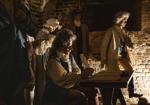
Before the nation celebrates its 250th, these Charleston mannequins represent Charlestonians seizing and storing tea in the exchange building without paying the tax.
Local battles, far-reaching implications
Among the battles in the early days of the American Revolution, the town of Ninety Six in 1775 saw a critical action — though between Loyalists and Patriots. The Upstate fort also was a site of another battle in the long southern campaign as the British tried to control the colony of South Carolina late in the war.
Another early encounter in the Palmetto State had implications that reached 1,000 miles to the north. A Patriot victory at the Battle of Bloody Point near Daufuskie Island in July 1775 led to the capture of 16,000 pounds of British gunpowder. The powder was shipped north and bolstered Washington’s siege of British force ensconced in Boston.
“It allows Washington to sustain the siege long enough to force the British evacuation,” Thomas said.
After a number of encounters early in the war, conflicts between the American and British troops quieted for nearly three years following the Patriot victory at Sullivan’s Island. By 1779, the British once again turned their attention southward.
Having been unable to break the revolt in the north, the British hoped that they’d be able to mobilize what they perceived as a more prominent Loyalist sentiment in the South. It was a strategy that, while producing some victories, ultimately failed.
They did capture one prize: Charleston.
In 1776, the Patriots successfully fended off the Royal Navy off Sullivan’s Island, but fortunes had flipped by the summer of 1780. Charleston fell in a siege in 1780 and British troops scored a major win in Camden.
Some of the other notable battles and moments in the war included Waxhaws, Hobkirk Hill, Kings Mountain and Eutaw Springs, a 1781 encounter many consider South Carolina’s last significant battle in the American Revolution.
British Gen. Charles Cornwallis surrendered at Yorktown, Va., on Oct. 19, 1781 — five weeks after the Battle of Eutaw Springs.
“The only reason Cornwallis is in Yorktown is because he couldn’t win in South Carolina,” Grimsley said.
Despite the surrender at Yorktown, fighting in South Carolina continued through 1782.
Gen. Nathaniel Greene was the American officer, a Quaker from Pennsylvania, who lost battles but scored strategic victories by draining the British of their strength and keeping them from occupying all of South Carolina. He also was the officer who liberated Charleston at the end of 1782.
The war here also was won by the likes of Francis Marion, William Moultrie and Andrew Pickens, Charles Pinckney, William Henry Drayton, Daniel Morgan, Christopher Gadsden and Thomas Sumter.
Marion’s troops crisscrossed the Pee Dee to fight the British and local Loyalists. Marion is depicted in a painting that hang inside the South Carolina Statehouse. It features Burch’s Mill where in June 1782 he granted mercy to Loyalist militia he had so long fought as long as they surrendered.
Of course, there were many others, including the Laurens family of Berkeley County.
Plantation owner Henry Laurens, one of the richest men in colonial America, was captured by the British at sea while returning from Europe. They charged him with treason and locked in the Tower of London, making him the first and only American ever imprisoned there.
His son, John Laurens, died in the Battle of Combahee River in Colleton County in 1782. His death was one of the last documented casualties in the Revolution.
Next year’s celebration of Carolina Day will be something not to be missed, according to Grimsley. He’s not looking to upstage the July 4 celebration, but he is intent on ensuring that South Carolina’s place in that great struggle gets its due.
“We’re going to bring national and international media to Charleston next year to remind people that there’s a lot more to the story of the 4th of July 1776. It has to do with things that went on all over the country, especially in South Carolina,” he said.
–postandcourier.com

